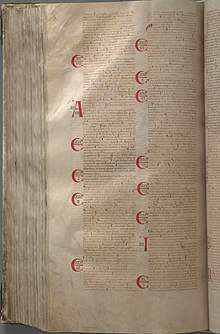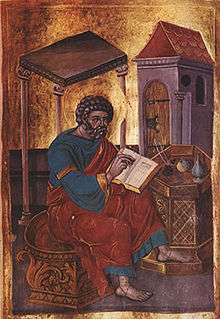Mark 7
Mark 7 is the seventh chapter of the Gospel of Mark in the New Testament of the Christian Bible. This chapter explores Jesus' relationships with both fellow Jews and Gentiles. Jesus speaks with the Pharisees and scribes, and then with his disciples, about defilement, and then heals two gentiles. Scholars debate just how much of this reflects Jesus' own view and how much is reflective of the conflict between Jewish and Gentile converts in the early Church.
| Mark 7 | |
|---|---|
 The Latin text of Mark 5:8–8:13 in Codex Gigas (13th century) | |
| Book | Gospel of Mark |
| Category | Gospel |
| Christian Bible part | New Testament |
| Order in the Christian part | 2 |
Text
The original text was written in Koine Greek. This chapter is divided into 37 verses.
Textual witnesses
Some early manuscripts containing the text of this chapter are:
- Codex Vaticanus (325-350; complete)
- Codex Sinaiticus (330-360; complete)
- Codex Bezae (~400; complete)
- Codex Alexandrinus (400-440; complete)
Clean and unclean

| Gospel of Mark |
|---|
Some Pharisees and some of the teachers of the Jewish law (scribes) come from Jerusalem to see Jesus, presumably in Galilee. Protestant Tübingen theologian Karl Heinrich Weizsäcker suggested that they had been sent to Jesus as a formal deputation.[1]
They see some of his disciples eating without washing their hands. Mark then explains to his audience the Jewish custom of washing before dinner, indicating a non-Jewish audience. The Expositor's Greek Testament speaks of Mark writing "from the Gentile point of view";[2] the Cambridge Bible for Schools and Colleges suggests the explanation was "for Roman readers".[3] The Pharisees and scribes ask Jesus why they are not obeying the custom and Jesus replies with a quote from Isaiah 29:13 and tells them "You have let go of the commands of God and are holding on to the traditions of men".[4] He rebukes them for letting a man who makes an offering to God, i.e. money to the priests, no longer help his parents, in violation of the fifth commandment. That this was done is not found in other sources of the period, although "...rabbinic Jewish texts suggest that vows may be broken in such circumstances." (Miller 29)
He calls people to listen to him and explains that "Nothing outside a man can make him 'unclean' by going into him. Rather, it is what comes out of a man that makes him 'unclean.'" (15) Later his disciples (students) tell him they didn't understand him and he scolds them for being "dull". He explains to them that food cannot make a person unclean but "What comes out of a man is what makes him 'unclean.' For from within, out of men's hearts, come evil thoughts, sexual immorality, theft, murder, adultery, greed, malice, deceit, lewdness, envy, slander, arrogance and folly. All these evils come from inside and make a man 'unclean.'" (20-23) meaning intention of the "heart" is more important than ritual. What foods you eat will not matter to God.
Biblical commentator C. M. Tuckett notes that verses 9, 14, 18 and 20 all open with Greek: ελεγεν αυτοις (elegen autois, "he said to them"), suggesting that several texts have been brought together in this section, and the changes of venue and audience in verses 14 and 17 suggest "that different traditions are being brought together".[5]
According to John J. Kilgallen, "...ultimately what is at stake here is knowledge of the divine will: Who knows best what God wants human beings to do." (135) This view is contrasted to the controversy, such as at the Council of Jerusalem, within the Early Church over just how much Mosaic law one must obey. Mark uses this story as evidence for his view in the Pauline direction, making scholars question how much of it is actually Jesus' own teaching and how much of it is Mark trying to win Gentile converts. If the author really is Saint Mark then this would indicate that his group, Peter's circle, had come around in the Pauline direction.
The saying, without the explanation, is also found in the Gospel of Thomas saying 14.[6]
The Syrophoenician woman and the deaf mute man
Jesus then travels to the cities of Tyre and Sidon in what is now Lebanon. Mark tells the story of the Syrophoenician woman who finds Jesus at a friend's house in Tyre and begs him to heal her demon possessed daughter. He brushes her off, saying:
- First let the children eat all they want, for it is not right to take the children's bread and toss it to their dogs [7]
The New King James Version refers to "little dogs" (Greek: κυναρίοι, kynarioi) and the Amplified Bible refers to "pet dogs". According to the Cambridge Bible for Schools and Colleges, "the heathen are compared not to the great wild dogs infesting Eastern towns (1 Kings 14:11; 1 Kings 16:4; 2 Kings 9:10), but to the small dogs attached to households".[3]
The children are the children of Israel (Matthew's text refers to the "lost sheep of the house of Israel" [8]) and the little dogs are the Gentiles, a metaphor also found in other Jewish writing.[9]
"'Yes, Lord,' she replied, 'but even the dogs under the table eat the children's crumbs.'" (28) Impressed with her answer, he tells her to go home and she returns home to find her daughter healed. This is one of the few times, and the only time in Mark's gospel, that Jesus performs a miracle at a distance, that is he does not touch nor is he near the girl. He only says it will be done and it is done, by his will alone. This passage shows that, according to Mark, Jesus' primary mission was to the Jews first and only then the Gentiles but Gentiles, as long as they have belief, can be part of that mission as well.
Jesus then goes to the Decapolis region and the Sea of Galilee. The Pulpit Commentary suggests his journey took him from Tyre "first northwards through Phoenicia, with Galilee on his right, as far as Sidon; and thence probably over the spurs of Libanus (Mount Lebanon) to Damascus, mentioned by Pliny as one of the cities of the Decapolis. This would bring him probably through Caesarea Philippi to the eastern coast of the Sea of Galilee".[10] Here he comes across a man who is deaf and mute. He touches his ears and touches his tongue with his own spittle and says "Ephphatha! (which means, 'Be opened!')" (Mark 7:34), Mark translating from the Aramaic. The man regains his hearing and speech and word quickly spreads. In this miracle, as opposed to the woman's healing, Jesus uses specific techniques, (the touching, the spit, the word), to effect a cure. This passage could be considered a fulfillment of Isaiah 35:5-6.
The argument with the Pharisees about food laws and the Syrophoenician woman are also found in Matthew 15:1-28
He charged them (Greek: διεστέλλετο, diestelleto) not to tell anyone.[11] "The word is a strong one: 'he gave them clear and positive orders' not to tell anyone".[10]
See also
References
- Referred to, but disputed, by Meyer in Meyer's NT Commentary on Mark 7, accessed 9 June 2017
- Expositor's Greek Testament on Mark 7, accessed 20 November 2017
- Cambridge Bible for Schools and Colleges on Mark 7, accessed 20 November 2017
- Mark 7:8
- Tuckett, C. M., Mark in Barton, J. and Muddiman, J. (2001), The Oxford Bible Commentary, p. 899
- Saying 14
- Mark 7:27
- Matthew 15:24
- Kilgallen, p. 138)
- Pulpit Commentary on Mark 7, accessed 10 June 2017
- Mark 7:34
Sources
- Kilgallen, John J., A Brief Commentary on the Gospel of Mark Paulist Press 1989 ISBN 0-8091-3059-9
Further reading
| Wikimedia Commons has media related to Gospel of Mark - Chapter 7. |
- Brown, Raymond E., An Introduction to the New Testament Doubleday 1997 ISBN 0-385-24767-2
- Miller, Robert J., The Complete Gospels Polebridge Press 1994 ISBN 0-06-065587-9
External links
- Mark 7 King James Bible - Wikisource
- English Translation with Parallel Latin Vulgate
- Online Bible at GospelHall.org (ESV, KJV, Darby, American Standard Version, Bible in Basic English)
- Multiple bible versions at Bible Gateway (NKJV, NIV, NRSV etc.)
| Preceded by Mark 6 |
Chapters of the Bible Gospel of Mark |
Succeeded by Mark 8 |